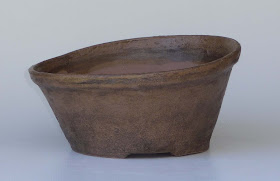It's the big pots that did it. The straws that broke my back. Well not exactly but getting a large piece of clay to a uniform thickness and flat using a hand roller and a couple of sticks is not easy. Making smaller pieces and then joining them will not produce a marketable product of the right standard. Pieces of clay which have been rolled in different directions and not joined in the same alignment may choose to go their separate ways later during firing. At the very least the joins are hard to hide.
I even made a new hand roller out of large diameter PVC pipe filled with concrete. It was good but heavy.
My conscience and chair of our ethics committee (my dear wife) has just reminded me as I write this, about hand building with a capital H and the possibility of the compromise I was making to my artisan's principles. Ha, well from now on they kick in after the clay has been rolled.
I say from now on because Father's day has just come early with the arrival of my new slab roller from the good old USof A. Two weeks in the mail from order; thank you internet and USPS.
The roller from North Star has an operating width of 24 inches, is gear driven and has two counter-rotating knurled aluminium rollers. It has individual depth adjustment on each side. This is how I bought it - bare of a table, so I could do a custom setup, which I have now done.
I even made a new hand roller out of large diameter PVC pipe filled with concrete. It was good but heavy.
My conscience and chair of our ethics committee (my dear wife) has just reminded me as I write this, about hand building with a capital H and the possibility of the compromise I was making to my artisan's principles. Ha, well from now on they kick in after the clay has been rolled.
I say from now on because Father's day has just come early with the arrival of my new slab roller from the good old USof A. Two weeks in the mail from order; thank you internet and USPS.
The idea was to make a movable feed in table that I could position adjacent to my work bench as I needed it. This picture shows that part and the wheels just under one end so it moves like a wheel barrow.
And here we are with it butted up to the workbench. You can see my rollers and depth sticks on the shelf under the bench - can't see that I'll be using them much anymore, what a shame! I wonder what I'll do tomorrow?






















